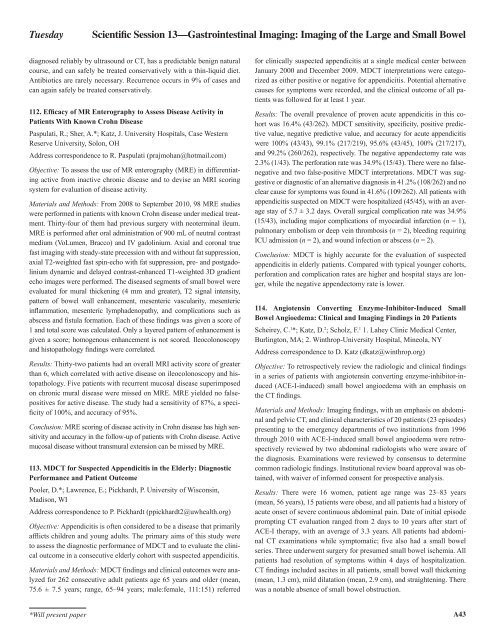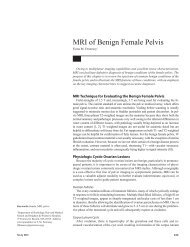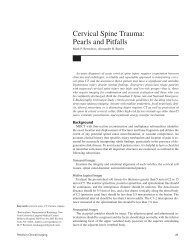Scientific Session 1 â Breast Imaging: Mammography
Scientific Session 1 â Breast Imaging: Mammography
Scientific Session 1 â Breast Imaging: Mammography
Create successful ePaper yourself
Turn your PDF publications into a flip-book with our unique Google optimized e-Paper software.
Tuesday<strong>Scientific</strong> <strong>Session</strong> 13—Gastrointestinal <strong>Imaging</strong>: <strong>Imaging</strong> of the Large and Small Boweldiagnosed reliably by ultrasound or CT, has a predictable benign naturalcourse, and can safely be treated conservatively with a thin-liquid diet.Antibiotics are rarely necessary. Recurrence occurs in 9% of cases andcan again safely be treated conservatively.112. Efficacy of MR Enterography to Assess Disease Activity inPatients With Known Crohn DiseasePaspulati, R.; Sher, A.*; Katz, J. University Hospitals, Case WesternReserve University, Solon, OHAddress correspondence to R. Paspulati (prajmohan@hotmail.com)Objective: To assess the use of MR enterography (MRE) in differentiatingactive from inactive chronic disease and to devise an MRI scoringsystem for evaluation of disease activity.Materials and Methods: From 2008 to September 2010, 98 MRE studieswere performed in patients with known Crohn disease under medical treatment.Thirty-four of them had previous surgery with neoterminal ileum.MRE is performed after oral administration of 900 mL of neutral contrastmedium (VoLumen, Bracco) and IV gadolinium. Axial and coronal truefast imaging with steady-state precession with and without fat suppression,axial T2-weighted fast spin-echo with fat suppression, pre- and postgadoliniumdynamic and delayed contrast-enhanced T1-weighted 3D gradientecho images were performed. The diseased segments of small bowel wereevaluated for mural thickening (4 mm and greater), T2 signal intensity,pattern of bowel wall enhancement, mesenteric vascularity, mesentericinflammation, mesenteric lymphadenopathy, and complications such asabscess and fistula formation. Each of these findings was given a score of1 and total score was calculated. Only a layered pattern of enhancement isgiven a score; homogenous enhancement is not scored. Ileocolonoscopyand histopathology findings were correlated.Results: Thirty-two patients had an overall MRI activity score of greaterthan 6, which correlated with active disease on ileocolonoscopy and histopathology.Five patients with recurrent mucosal disease superimposedon chronic mural disease were missed on MRE. MRE yielded no falsepositivesfor active disease. The study had a sensitivity of 87%, a specificityof 100%, and accuracy of 95%.Conclusion: MRE scoring of disease activity in Crohn disease has high sensitivityand accuracy in the follow-up of patients with Crohn disease. Activemucosal disease without transmural extension can be missed by MRE.113. MDCT for Suspected Appendicitis in the Elderly: DiagnosticPerformance and Patient OutcomePooler, D.*; Lawrence, E.; Pickhardt, P. University of Wisconsin,Madison, WIAddress correspondence to P. Pickhardt (ppickhardt2@uwhealth.org)Objective: Appendicitis is often considered to be a disease that primarilyafflicts children and young adults. The primary aims of this study wereto assess the diagnostic performance of MDCT and to evaluate the clinicaloutcome in a consecutive elderly cohort with suspected appendicitis.Materials and Methods: MDCT findings and clinical outcomes were analyzedfor 262 consecutive adult patients age 65 years and older (mean,75.6 ± 7.5 years; range, 65–94 years; male:female, 111:151) referredfor clinically suspected appendicitis at a single medical center betweenJanuary 2000 and December 2009. MDCT interpretations were categorizedas either positive or negative for appendicitis. Potential alternativecauses for symptoms were recorded, and the clinical outcome of all patientswas followed for at least 1 year.Results: The overall prevalence of proven acute appendicitis in this cohortwas 16.4% (43/262). MDCT sensitivity, specificity, positive predictivevalue, negative predictive value, and accuracy for acute appendicitiswere 100% (43/43), 99.1% (217/219), 95.6% (43/45), 100% (217/217),and 99.2% (260/262), respectively. The negative appendectomy rate was2.3% (1/43). The perforation rate was 34.9% (15/43). There were no falsenegativeand two false-positive MDCT interpretations. MDCT was suggestiveor diagnostic of an alternative diagnosis in 41.2% (108/262) and noclear cause for symptoms was found in 41.6% (109/262). All patients withappendicitis suspected on MDCT were hospitalized (45/45), with an averagestay of 5.7 ± 3.2 days. Overall surgical complication rate was 34.9%(15/43), including major complications of myocardial infarction (n = 1),pulmonary embolism or deep vein thrombosis (n = 2), bleeding requiringICU admission (n = 2), and wound infection or abscess (n = 2).Conclusion: MDCT is highly accurate for the evaluation of suspectedappendicitis in elderly patients. Compared with typical younger cohorts,perforation and complication rates are higher and hospital stays are longer,while the negative appendectomy rate is lower.114. Angiotensin Converting Enzyme-Inhibitor-Induced SmallBowel Angioedema: Clinical and <strong>Imaging</strong> Findings in 20 PatientsScheirey, C. 1 *; Katz, D. 2 ; Scholz, F. 1 1. Lahey Clinic Medical Center,Burlington, MA; 2. Winthrop-University Hospital, Mineola, NYAddress correspondence to D. Katz (dkatz@winthrop.org)Objective: To retrospectively review the radiologic and clinical findingsin a series of patients with angiotensin converting enzyme-inhibitor-induced(ACE-I-induced) small bowel angioedema with an emphasis onthe CT findings.Materials and Methods: <strong>Imaging</strong> findings, with an emphasis on abdominaland pelvic CT, and clinical characteristics of 20 patients (23 episodes)presenting to the emergency departments of two institutions from 1996through 2010 with ACE-I-induced small bowel angioedema were retrospectivelyreviewed by two abdominal radiologists who were aware ofthe diagnosis. Examinations were reviewed by consensus to determinecommon radiologic findings. Institutional review board approval was obtained,with waiver of informed consent for prospective analysis.Results: There were 16 women, patient age range was 23–83 years(mean, 56 years), 15 patients were obese, and all patients had a history ofacute onset of severe continuous abdominal pain. Date of initial episodeprompting CT evaluation ranged from 2 days to 10 years after start ofACE-I therapy, with an average of 3.3 years. All patients had abdominalCT examinations while symptomatic; five also had a small bowelseries. Three underwent surgery for presumed small bowel ischemia. Allpatients had resolution of symptoms within 4 days of hospitalization.CT findings included ascites in all patients, small bowel wall thickening(mean, 1.3 cm), mild dilatation (mean, 2.9 cm), and straightening. Therewas a notable absence of small bowel obstruction.*Will present paperA43
















